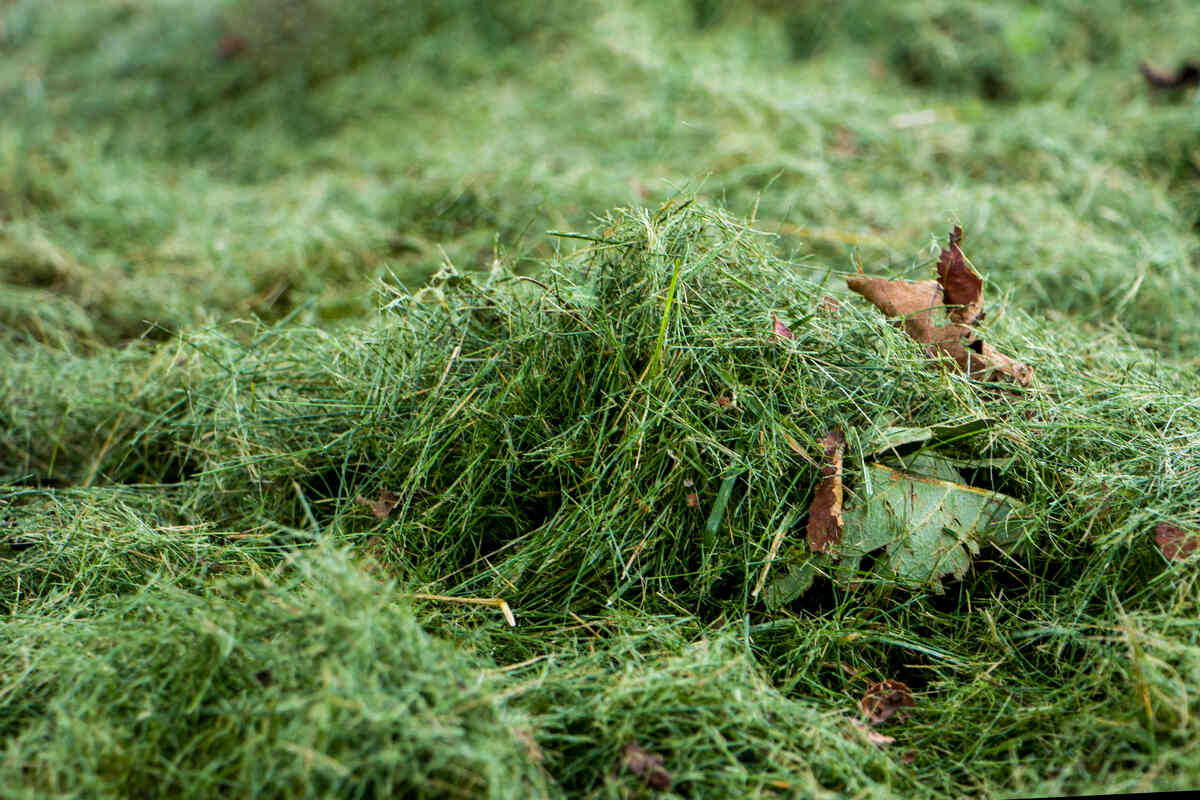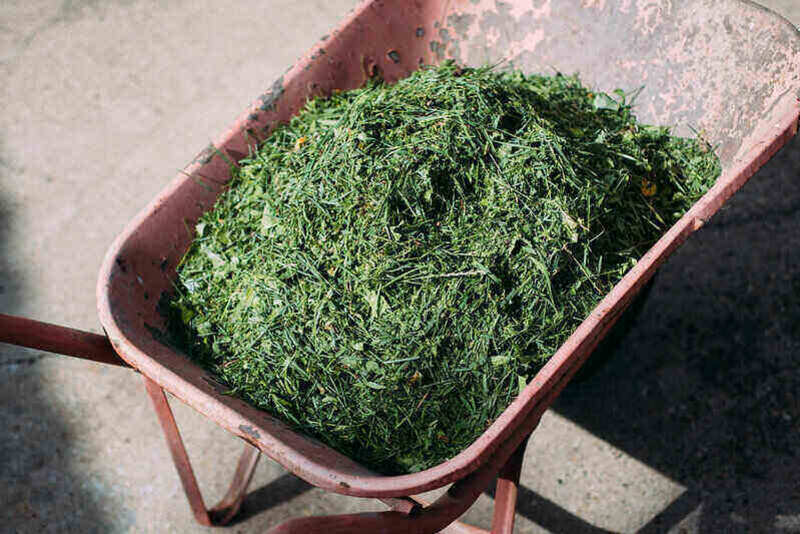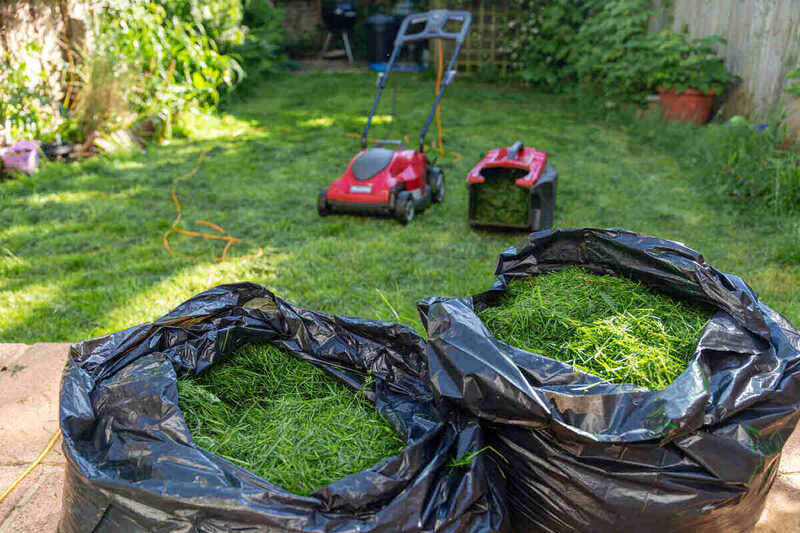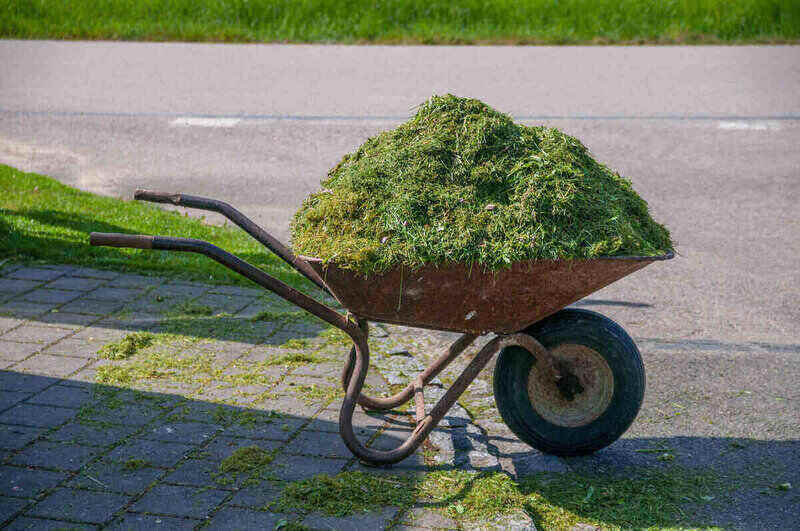
Mulching grass clippings is the best mowing method for a low-cost, thriving, eco-friendly lawn. It controls the weeds, improves the soil, saves water, and feeds the grass for free, but it can’t fix everything.
When your lawn needs a major intervention, like treating a fungal disease or overseeding, bagging is the better tactic. This article covers all the ins and outs of mulching vs. bagging grass clippings so you’ll know when to mulch and when to bag to get the best results.
What is the Difference Between Mulching and Bagging?
Mulching grass clippings follows the natural lifecycle. It allows the cut blade tips to fall and decompose on the lawn, returning some of the plant’s moisture and nutrients to the soil.
Bagging grass clippings interrupts this cycle by collecting and removing clippings from the lawn.
Both methods have advantages and drawbacks. But before we get into details, here’s a quick comparison chart.
Quick Comparison: Mulching vs. Bagging
| Mulching | Bagging | |
| Time and effort | It requires less muscle work and 30% to 38% less time. | More time-consuming. It requires emptying the bag regularly. |
| Equipment needed* | Mulching plug ($7 to $80). Mulching mower ($250 to $350 low-end price). | Mower with a bag attachment ($80 to $100 low-end price). Or a rake and a wheelbarrow. |
| Professional Cost | Standard rate. | Can increase mowing fees by up to 50%. |
| Lawn Health | Improves soil and turf health. Increases stress resistance. | Prevents pests and diseases. Helps solve specific lawn care issues. |
| Lawn appearance | Visible clippings. Occasional grass clumps. | Ensures a clean, manicured lawn. |
| Eco-friendly | Saves water. Reduces chemical fertilizer use. | It can add to landfill pollution. |
*Note: You can mulch with a regular rotary mower if you close the side discharge opening and use a mulching plug. You get the best results if you:
- Keep the blades sharp.
- Mow regularly (every 5 to 10 days).
- Cut only dry grass.
- Cut no more than 1/3 of the grass blade to keep the clippings short.
Pro Tip: Alternate between bagging and mulching strategically. For example, you can bag the grass clippings in late spring when weeds pop their seed heads and mulch during the summer to protect soil moisture.
See Related:
Advantages of Mulching Grass Clippings

Is it better to mulch or bag grass clippings? It depends on what your lawn needs and what you prefer. Mulching grass clippings, or grasscycling, simplifies and speeds up DIY mowing and lowers the costs of hiring a professional:
- Low effort: Mowing takes less effort and up to 38% less time when you don’t need to empty the mower bag or haul clippings away.
- Money saver: Leaving the cuttings on the lawn is part of the standard mowing service, while bagging can increase the cost.
But mulching doesn’t only save you money on mowing. Turning grass clippings into mulch also reduces fertilization, watering, aeration, and weed control costs:
- Natural fertilization: Experts at the University of Missouri say grass clippings are similar to a 4-1-2 fertilizer and can provide up to 25% of your lawn’s total annual fertilizer needs.
- Lawn hydration: Grass clippings are 80% to 85% water; part evaporates, but part is released into the soil and hydrates the lawn.
- Moisture preservation: The mulch layer protects soil moisture by reducing evaporation.
- Weed control: The layer of mulched grass debris shades the soil and prevents dormant weed seeds from germinating.
Mulching grass clippings is one of the simplest environmentally-friendly practices you can adopt. Besides saving water and reducing herbicide and pesticide use, it also:
- Prevents soil erosion: Mulched grass clippings act like a natural shield against the rough force of heavy rain and high winds, protecting the topsoil from erosion.
- Reduces landfill pollution: Instead of adding to the landfill leachate contaminating waterways, the cut grass releases nutrients into a hungry lawn.
See Related: Reasons to Use Grass Clippings as Mulch
Disadvantages of Mulching Grass Clippings
No mowing strategy is bullet-proof, and mulching also has its weak points. Here are the main mulching drawbacks (and their solutions) to consider when choosing between mulching grass vs. bagging:
- Can spread diseases: Grass clippings infected with fungi can spread the spores to healthy grass. Bag the clippings until you treat the lawn disease.
- Can lead to clumps: Mowing wet grass or overly tall turf can cause clumps on the lawn. To prevent this, keep the lawn mower blades sharp, only mow dry grass, and trim the turf regularly to keep clippings short (under 1/2 inch). Bag the clippings if they are too long or wet.
- Decreased curb appeal: A mulched lawn looks more like a textured wool rug than a velvet carpet because of the visible grass clippings. To manage it, use a mulching mower to get finer clippings and keep healthy soil to speed up decomposition.
See Related:
Advantages of Bagging Grass Clippings

What is the point of bagging the grass clippings? While many homeowners (myself included) choose to mulch the clippings, bagging comes with some important advantages:
- Less mess: Mowing with a bagger or a grass catcher leaves a cleaner lawn with no clumps or fine grass to stick to your shoes or your dog’s paws.
- Controls disease: Bagging the clippings helps control fungal infestations by removing infected blades that would otherwise spread the spores.
- Prevents pests: Long grass clippings decompose slowly and can build up on existing thatch, attracting lawn grubs and chinch bugs. Bag tall grass to prevent pests.
- Alternative use: Grass clippings collected in the mower bag can be used as mulch on your veggie beds or added to your compost bin.
See Related:
Disadvantages of Bagging Grass Clippings
Bagging the grass clippings requires more work and can harm the environment. The main drawbacks of bagging lawn clippings include:
- More time and physical effort: Removing and emptying the mower bag repeatedly requires more time and physical effort.
- Increased yard work: Without the mulch’s benefits, you may need to spend more time (and money) on aeration, watering, and weeding.
- A waste of valuable nutrients: Grass clippings sent into landfills waste valuable nitrogen, phosphorus, potassium, and micronutrients that many commercial fertilizers lack.
- Cost of disposal: Depending on your location and what’s included in your local utility service, you can pay extra for grass clippings removal.
- Contributes to landfill waste: According to the EPA, “landfills are running out of space,” even though the amount of yard waste deposited into landfills has dropped from 18% to 7% over the last 25 years.
And it’s not only about space. Experts at the University of Idaho say grass clippings increase landfill leachate, which adds a steady flow of contaminants to our groundwaters.
Note: Landfill leachate is a toxic liquid that forms when rainwater filters through landfill waste, picking up pollutants it carries into the soil and groundwater.
When to Choose Mulching vs. Bagging

Mulching grass clippings is the go-to lawn care routine for a healthy lawn with a regular mowing schedule. Bagging grass clippings, on the other hand, is an occasional intervention for cleaning the yard or dealing with a lawn problem.
Best Times to Mulch
Generally: Overall, mulching grass clippings is almost always the better choice for healthy lawns with a regular mowing schedule.
Special situations: When it’s better to mulch grass blades instead of bagging (even if you usually bag the cuttings):
- Nutrient-deficient soil.
- Soil is poor in organic matter (e.g., sandy soil).
- Steep lawn exposed to runoff and erosion.
- Drought conditions (you need to conserve soil moisture).
Best Times to Bag
Generally: Homeowners who bag the grass clippings as a habit usually do it for the clean, neat appearance.
Special situations: When it’s better to bag grass clippings instead of mulching (even if mulching is your routine):
- When the grass is overly tall or wet.
- If the thatch layer is over 1/2 inch thick.
- Your lawn has a fungal disease.
- The weeds in your lawn have seedheads (e.g., dandelion flowers).
- It’s a newly seeded or sodded lawn.
- You’re preparing to overseed.
- During spring or fall clean-up.
What to do with bagged clippings: Depending on their quality, you can compost them, use them as mulch on flower beds, or dispose of them according to local regulations.
My Tip: I leave the clippings on the lawn in the spring to feed the grass and collect them during summer to cover the vegetable beds and preserve the soil moisture.
See Related:
FAQ
If you mow regularly and the cuttings are under 1/2 inch long, you can use a good-quality rotary mower — close the rear or/and side discharge chute and use a mulching plug. If you mow less often or want the clippings to decompose faster, you need a mulching mower or a mulching kit installed on your regular mower.
Coarser grass types, such as Bermuda, Zoysia, and St. Augustine, may benefit from occasional bagging, especially during their peak growing season. Fine-bladed grasses, such as fine fescues or Kentucky bluegrass, decompose more easily.
Generally, you should mulch the lawn 80% to 90% of the time and bag it when specific conditions warrant (e.g., fall leaf removal, overseeding, tall grass).
Take Your Lawn From Good to Gorgeous
Ready for a gorgeous, thick lawn with less work? Apply these mulching and bagging tips, or find a skilled lawn care professional to work their magic. From flawless mowing to aeration and installing new sod, LawnStarter pros can keep your lawn lush and vibrant without your lifting a finger.
Sources:
- “Grass Clippings, Compost and Mulch: Questions and Answers.” By Manoj Chhetri,
- MU Extension horticulture field specialist, and Chris Starbuck, Department of Horticulture. University of Missouri Extension.
- “Don’t Bag It! Recycle Your Grass Clippings” By W. Michael Colt, Extension horticulturist, Bob Rynk, Extension waste management engineer, Susan Bell, Extension educator, and William J. Johnston, agronomist and turfgrass science expert. University of Idaho College of Agriculture.
- “Bagging Grass Clippings Not Always the Best Idea” By Ellen Brightwell. Martin-Gatton College of Agriculture, Food and Environment. University of Kentucky.
- “Mowing To Recycle Grass Clippings: Let the Clips Fall Where They May!” By David R. Chalmers, emeritus associate professor, Judy Booze-Daniels, former research associate, and Michael Goatley, turfgrass specialist. Virginia Tech.
Main Photo Credit: Iryna / Adobe Stock